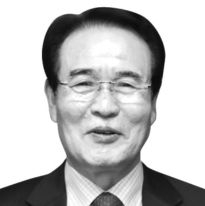A step closer to the creation of megacities

Kwon Kyung-seok
The author is former vice chairman of the Presidential Committee on Local Autonomy Development and the head of the regional autonomy division of the JoongAng Ilbo’s Reset Korea campaign.
Chairman Kim Gi-hyeon of the People Power Party (PPP) has stressed the need for Gimpo City in Gyeonggi to merge with Seoul. He said that the governing party will adopt a policy to push forward a plan to merge other neighboring cities of Seoul — such as Gwangmyeong, Guri, Hanam and Goyang — with the capital, should the residents these cities so desire. The announcement has a big impact as a ruling of this magnitude affects real estate, transportation and school policies of the capital region, as well as Seoul’s competitiveness.
Gimpo City’s demand to incorporated into Seoul was raised after Gyeonggi Gov. Kim Dong-yeon pushed forward his election pledge of separating the province into South Gyeonggi and North Gyeonggi. Gimpo Mayor Kim Byung-soo has been advocating for the city to become a part of Seoul, since 85 percent of Gimpo’s population commutes to Seoul and the two cities share the same transportation, economic and cultural networks.
If Gimpo merges into Seoul, it will be possible to develop the economy backing the western part of Seoul. Gimpo’s overseas trade, foreign investment and tourism can become a part of Seoul’s resource. Seoul’s “Han River Renaissance Project” and the “Mega Seoul Project” will gain momentum to help the capital become the hub city of East Asia. After the possibility of a merger was mentioned, Gov. Kim criticized it as a “ridiculous idea to divide the province,” and his Democratic Party (DP) dismissed the idea as a “stopgap measure to win votes of the capital region before the next parliamentary election.”
Major media outlets asked the politicians to take a prudent approach because of its far-reaching impact. Moreover, regional autonomous governments are paying keen attention to establishing collaborative governance as a global trend.
In 2015, China launched a major integration project to build the Beijing-Tianjin-Hebei city cluster. From 2010 to 2015, France completed the Metropole Du Grand Paris (Greater Paris Metropolis) project by incorporating 131 municipalities around Paris. Other examples of megacity projects around the world include Japan’s Kansai alliance centered on Osaka, and the Integrated Development Program of Yangtze River Delta of China, involving a group of cities around Shanghai.
Let’s take a look at the feasibility of the integration of Gimpo into Seoul. First, it is a matter of changing the jurisdiction of regional governments, which is in line with the basic principle of reorganizing the regional administrative systems. According to the relevant decrees, the adjustment of the local government’s administrative jurisdiction should take into account geographical conditions and the lifestyle and economic areas of the residents, and must reflect administrative efficiency and the convenience of its residents.
Second, the integration plan is a move to resolve the residents’ inconvenience, burdens and administrative inefficiency caused by the mismatch of administrative zones and the residents’ lifestyle and economic zones by adjusting the boundaries between the cities in the capital region. In other words, as the total population and the total area of the Seoul metropolitan area remain unchanged, it does not affect other regions. Therefore, interpreting the merger as the first expansion of Seoul in 50 years or a disruption of the balanced development of the country is misleading.
Third, there is no reason for the neighboring cities to hesitate over being integrated into Seoul if their residents want it. No one has any reason to stop an effort to improve the residents’ lives and secure a growth engine. As the examples of other countries’ alliance systems for their capital regions are inappropriate for Korea’s situation, it is not suitable to directly benchmark their cases. But in terms of streamlining the administrative system, it is necessary to refer to Tokyo Metropolis’s administrative hierarchy, which includes special wards, cities, towns and villages.
Fourth, revitalizing rural regions under threat of disappearing from the map is a challenge for the country. Balanced development of regions and decentralization of powers, human resources and materials in the capital region are key, but the situation is worsening despite continuous efforts by past governments. When no substantial outcomes came from the alliance projects of cities and provinces in the past, the Yoon Suk Yeol administration announced a policy to operate four special districts led by regional governments. The central government proposed a system to offer drastic support to develop business, education, medical and cultural content of the regions in both quantity and quality.
What matters most is not slogans, but actions. Regional governments should be given powers and they must be held accountable. We should learn from mistakes of the past, and the capital region and other areas must compete and cooperate to grow the pie of shared growth. It is wasteful to present all kinds of policies. Making selections and focusing resources and efforts on hub cities is the best policy.
Translation by the Korea JoongAng Daily staff.










with the Korea JoongAng Daily
To write comments, please log in to one of the accounts.
Standards Board Policy (0/250자)